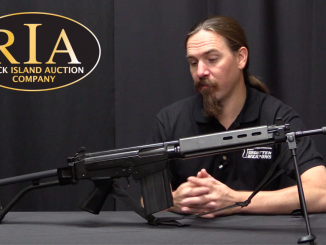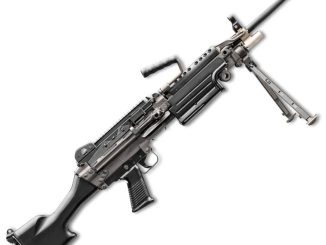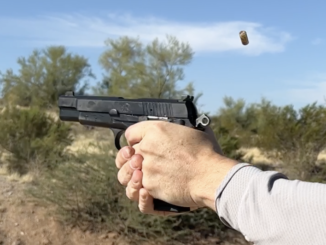I was planning to do a brief post today on a photo of a Spencer-Lee slide-action rifle, but as I started looking I found more and more information about it. I’m going to need a lot longer to put it all together into a good article – but I stilled needed something for today. So without analysis I present this gallery of photos of prototype FN-49 #8:
Related Articles

Semiauto Rifles
FAL Paratrooper 50.63
This rifle sold for $7,475 at Rock Island on November 30, 2018. FN introduced the paratrooper folding-stock version of the FAL rifle in the early 1960s, and it became a very popular addition to their […]

Uncategorized
FN M249S Semiauto for Military Collectors
Get Entered to WIN this insane FN M249S! https://go.getenteredtowin.com/forgottenweapons DEADLINE to ENTER is 07/26/24 @ 11:59pm (PST). In 2015, FN USA introduced a Military Collector product line – semiautomatic versions of their military contract small […]

Semiauto pistol
First Shots: FN’s New High Power
Today I’m taking FN’s new High Power out to the range for some first shots. I’m curious to see if it really is more comfortable to shoot than the original High Power, and if it […]





















Too cool. Would this have been made before the war? As I understand it, development began circa 1936. This looks very close to my production FN-49 (a Venezuelan model).
Not being too familiar with the SAFN, I note that it was made in various calibers for various customers (7.9, 7.65, 7 x 57, .30-06, etc.). And that according to Guns of the World (Petersen 1972), the Egyptian version in 7.9 “has a matte black paint finish and a tendency to go full-automatic due to firing pin breakage”. (p.237)
Comments?
cheers
eon
I’ve probably only fired a few hundred rounds out of the 7mm SAFN. It works fine, uses Mauser or Springfield stripper clips. The Venezuelan version appears to be classic Gallic gloss black enamel over parkerizing.
Where this prototype differs from mine is in the muzzle end. There is a compensator, and a Mauser-type bayonet lug (any Mauser bayo that does not have a muzzle ring will fit). The gas adjuster appears very similar, although the factory gun has a spring that resembles the one on the FAL. I don’t know whether the absence of the upper forward handguard on the prototype is because it never had one or because it’s come adrift over the decades.
Other photos I’ve seen of “toolroom” SAFNs also lack that forward handguard section. Lots of military bolt-action rifles of the pre-1939 period had upper handguards only over the rear half of the barrel,probably both to save weight and also to reduce heat buildup on the thinner forward barrel half in rapid fire.
Strictly speaking,if the shooter is holding the rifle correctly, there really isn’t a need for a handguard on top of that section on a bolt-action. On the FN semi-auto rifle, of course, it helps protect the gas piston tube assembly from damage. That may have been why it was added on the production versions.
cheers
eon
Thanks! The FN-49 is a great rifle, but one that strikes me as having one foot in the past when introduced. It is an old school battle rifle with long wooden stock, finely machined steel, fixed box magazine, and seems anachronistic. A contemporary of the AK-47 and a near contemporary of the FAL, it was late to the party.
Some have said it is better than the M1 Garand in various respects, and it may be, but that was not the problem that needed solving in 1949.
Of course, there were other rifles of the same period that fit the same general design outline, such as the French MAS 49, the German wartime G43/K43, the Swedish Ljungman AG42 (also made in Denmark and Egypt in different chamberings), the Czech ZK420 and VZ52/57 series,and probably the best-known and most widely used, the Russian SKS (action scaled down from the prewar Simonov rifles).
The main deciding factor seems to have been availability. The European countries and arms-makers that built these rifles were predominantly ones that had been major arms exporters before being conquered by Germany, and needed new products ASAP to get their export markets back (in a world market glutted with WW2 surplus from all sides).
As such, projects that had been “almost ready for prime time” in ’39 looked like good bets as near-term catalog items while they got their R&D departments back up and running again.
As for neutral Sweden, they’d lost quite a few export customers due to having to walk a tightrope between the Allies and the Axis. Hence helping Egypt out with first the Hakim and then the Rashid variants of the AG42 was probably a smart move in trying to build goodwill in what was then a developing market, the Islamic Crescent.
Russia and later China exporting SKS carbines to anybody with the “correct politics” was less driven by market forces than strategic considerations. Sort of “If you buy the Proletarian World Tour Package, we’ll throw in enough brand-new rifles to arm your entire People’s Army for free”. Handy “door prize” if they wanted bases in Country A, or molybdenum from Country B, or whatever.
What these rifles did for their makers was give them a foot back in the door, plus time to develop the first-generation intermediate rifles like AK-47, Vz58, and the prototype FAL. (It was initially in the British 0.280in EM2 chambering, so technically counts in this class even though it finally emerged as a full-on battle rifle in 7.62×51.)
Rather like the 1946-49 U.S. car models based on 1940-42 platforms, coachwork, etc., while they may not have been “up to date” tactically or even technically, they kept the markets running and the order books full until the new models were ready for the showrooms.
cheers
eon
I like the Vz58 🙂
The design of the FN49 actually started in 1936, and probably would’ve entered service quite a bit sooner if not for the whole German conquest of Belgium.
And as far as being “a near contemporary of the FAL”? The FN-49 and the FAL were designed by the same person. Dieudonne Saive finished up the FN-49 and moved right on to designing the FAL.
Does this weapon have any similarities to the MAS 49, other than it looks sort of similar externally and has a similar name…
In that, the MAS was direct impingement, but I suppose what I am asking is does this have a similar lock up mechanism actuated by a piston instead of direct impingement.
The SAFN operates on a gas tappet system. Gas ducted off the barrel drives the tappet backwards through a hole in the upper receiver front face to hit the bolt carrier, driving it back against the recoil spring to start the unlocking sequence. The system is not unlike that of the German K43.
The MAS 49 and 49/56 rifles use a direct gas system; gas blows back through the tube into a cup in the front of the bolt carrier, forcing it backwards to begin the unlocking sequence. The Swedish Ljungman AG42, and the U.S. AR-15/M-16/M-4 family also use this principle.
Source; Small Arms of the World, 9th ed., pp. 220-222, 365-367.
cheers
eon
Aye, but how is the bolt locked on this rifle out of interest?
Thank you for the tappet information, but I mean is it a Fasmas type lock.
Oops. Sorry, misunderstood the question. (*headdesk*)
Both the SAFN and the MAS use a cam-locking system similar to that of the later FAL, and the earlier Tokarev rifle. That is, the bolt has a cam face on its lower rear corner which locks into a “ledge” or recess in the receiver. When the bolt carrier is forced backward in opening, this movement cams the bolt’s locking face upward and out of the recess.
Note that the bolt in none of these rifles rotates to lock or unlock, unlike the U.S. Garand-type action (M-1, M-14, M-1 Carbine, Ruger Mini-14, Beretta BM-59 series) or the AK series. It does however resemble the action of the SKS.
cheers
eon
Understand, thank you 🙂
Er… Why don’t they rotate out of interest, any technical reason? He he, is the direct impingement better without a rotary bolt in relation to the Mas?
Was a rotary bolt cheaper?
A rotary bolt gives better primary extraction; the rotation tends to break the case loose from the chamber walls. This reduces the chance of case-head separation, especially with brass that’s not quite right in the ductility department (too hard or too soft).
As to which is cheaper, it’s a toss-up, price-wise. Note that the Russians built huge numbers of the SKS (tilting, non-rotating bolt) and colossal numbers of the AK (rotating bolt). While cost wasn’t generally a factor with them “back in the day”, I doubt they’d have accepted Kalashnikov’s design if it couldn’t be produced at reasonable per-unit expenditure.
cheers
eon
The cute thing about rear “tilting” / locking bolts is that you can adjust for headspace by changing the locking shoulder. They are also easier to machine.
The Garand (and M-14) are the US “showing off” their incredible machining expertise.
The M-1 not only has one of the most complex receivers, the lock-up is helical, like a Lee Enfield or, indeed, the M-17 “Enfield” rifle.
The M-1 introduced “interchangeability” on a HUGE scale; Several major and dozens of minor manufacturers making parts that would go together correctly without fooling around with files or other nasty things.
They also used differential heat-treatment on many components to get the right hardness / toughness for each functioning surface.
An engineering and metallurgical work of art!
Ian, I would love to see a video on this